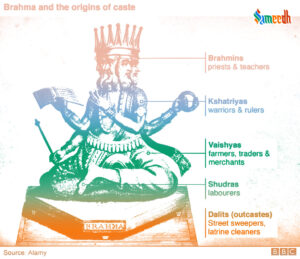Orthodox Hinduism traditionally recognizes a social hierarchy known as the caste system, which is based on the concept of varna. The varna system, mentioned in ancient Hindu scriptures like the Rigveda, divides society into four main categories or varnas, each with its own set of duties and responsibilities. The four social castes of Hinduism and their characteristics – an important yet misunderstood concept.

There are four social castes in Hinduism; Brahmins, Kshatriyas, Vaishyas and Shudras in decreasing order according to the hierarchy. This is often correlated with the Hindu Varna and Jati system where the former marked the professional identity of a person and the latter was the community’s recognition.
It was Dharma, religion and the code of conduct, which emphasised on maintaining this hierarchy. People born under these castes were to only follow and practise the careers authorised for them. A lower caste individual performing higher caste roles was considered against the law and acceptable for punishment.
It is believed that the four castes emerged from several of Brahma’s body parts, the creator of the Universe.
This is the caste of Hinduism stemming from Brahma’s head. They are the priests and teachers of the society, attributed with immense knowledge, wisdom and intellect. Just as the head is considered as the most important part of the body for encapsulating the brain, Brahmins too were known to be extremely valuable to society. They preached Dharma, religion and order of justice, by practice. It is believed that their embodiment of a vital organ gave them the spiritual powers to attain stages of the highest consciousness through meditation practices. Because of such superior strengths, Brahmins were called upon to initiate ceremonies of formal education, marriage, funerals and the likes to either bless or heal and empower the subjects involved. With their divine forces, they used to bestow positive energies and vibrations onto people and places of worship. Although Brahmins did not directly intervene with the state or kingdom’s administration, they used to guide and advise the rulers while any major decision was made or law was implemented. They were the most respectable people of the society and their approval on matters was often sought after by all other sections of people.
The second Varna was the ruler and warrior caste of the society. They emerged from Brahma’s hands, making them excellent fighters having been born with great physical strength and capabilities. They were equipped with combat skills, war tactics, weapons and governance from a young age. With their power and vigour, they often were the ones to reestablish Dharma or maintain the laws. Kshatriyas were taught by Brahmins and as governors, kings or princes, they used to take suggestions from the higher caste on political, economical and religious matters. This authoritative caste too was firmly respected and admired as they were not only royalty but also the protectors of the society in times of battles against other kingdoms. Qualities of bravery, might and courage were associated with them.
Vaishyas appeared from the thigh of Brahma. They were traders, farmers, merchants, artisans etc. These commoners used to focus on earning daily wages for themselves and their families. They learned skills only useful for living a decent life and did not actively participate in training combat techniques or gaining spiritual wisdom unlike the two upper castes. The ones who were landowners or rich businessmen enjoyed a comparatively richer lifestyle than their other caste members. As they dealt with the commerce of the society, many had a concrete economical power and influence too. Although they weren’t disregarded as lower castes, they weren’t deemed as the higher class either. In many cultures, Vaishyas practised wearing Janeu and initiating their Upanayana stage as well, a phase of learning and seeking religious knowledge and schooling. They were renowned for their street smartness and cunning in society as they were sharp with acquiring wealth by expanding their businesses.
This was the caste of the society created from Brahma’s feet. Shudras used to perform tasks for society that were more operational in nature. Their work revolved around building, engineering, cleaning and working as labourers. It is unfortunate that the nature of their jobs attracted much disrespect towards them and they were termed as the untouchables.
There was a reason, a purpose, for having the caste system. In today’s day and age, we observe that people often get ambitious about their profession. When unrealistic goals are not achieved, they get depressed. This concept of attempting to achieve higher professional pedigrees are getting worse by generation. As a result, the primary goal of Hinduism – to look within – is getting lost. The very purpose of caste system was to avoid this vicious cycle … to remind people that profession is not the end; rather, it is the means to the end. Rather than making profession your end goal, use the profession to do your duties and focus on the primary goal.
